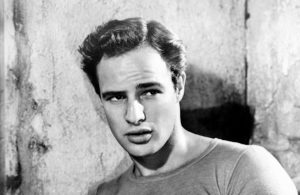 BRANDO 100, a two-week festival of classics starring Marlon Brando, with many films screening in 35mm, will run at Film Forum from Friday, December 13 to Thursday, December 26, in commemoration of the actor’s centennial year in 2024.
BRANDO 100, a two-week festival of classics starring Marlon Brando, with many films screening in 35mm, will run at Film Forum from Friday, December 13 to Thursday, December 26, in commemoration of the actor’s centennial year in 2024.
The series features performances by Brando (1924-2004), the rebellious iconoclast in his most iconic and lesser seen roles. From his rarely-screened feature debut as a paralyzed, depressed ex-GI in Fred Zinnemann’s THE MEN (1950); to his definitive Stanley Kowalski in Tennessee Williams’ A STREETCAR NAMED DESIRE (adapted to film in 1951 by Elia Kazan); to his Oscar-winning performance as dockworker Terry Malloy in Kazan’s ON THE WATERFRONT (1954), and his turn as the suave, wisecracking Sky Masterson in the 1955 musical GUYS AND DOLLS. Brando’s return to form as Mafia patriarch Don Vito Corleone in Francis Ford Coppola’s THE GODFATHER (1972) reminded Hollywood of his brilliance and earned Brando his second Oscar (which he refused in protest of Hollywood’s treatment of Native Americans). The following triumph, Bernardo Bertolucci’s X-rated sensation LAST TANGO IN PARIS (1972) would go on to spark debate about the ethics of consent in filmmaking, and APOCALYPSE NOW (1979), his second collaboration with Coppola, in which he plays a rogue Army officer who descends into madness, is remembered as one of Brando’s most enigmatic performances.
Other festival highlights include Brando’s sole directorial effort ONE-EYED JACKS (1961), Gillo Pontecorvo’s sweeping 19th-century anticolonial drama BURN! (1969), John Huston’s rarely-screened psychosexual drama REFLECTIONS IN A GOLDEN EYE (1967) starring Brando as an Army major with a lusty wife (Elizabeth Taylor) who finds himself attracted to a young male private in the 1940s South, and one of his last major roles in Andrew Bergman’s THE FRESHMAN (1990).
“Nobody, nothing, no amount of money can make him behave,” a 1954 profile in The New York Times Magazine stated of Brando. He shunned the Hollywood establishment and was selective about his roles, only choosing to take on projects that aligned with his vision to explore complex, nuanced characters, which he created using the intense, immersive acting style that would come to be known as the Method. “He has the ability to hold the reality of his character and the needs of the script simultaneously, making every performance electric,” wrote Stella Adler, Brando’s mentor who introduced him to the Stanislavski method.
Film historian and author Foster Hirsch will introduce the opening night screening of ON THE WATERFRONT on Friday, December 13 at 7:10 and REFLECTIONS IN A GOLDEN EYE on Thursday, December 26 at 1:00. Hirsch is Professor of Film at Brooklyn College and the author of numerous books on film and theater including A Method to Their Madness: The History of the Actors Studio and Hollywood and the Movies of the Fifties.
